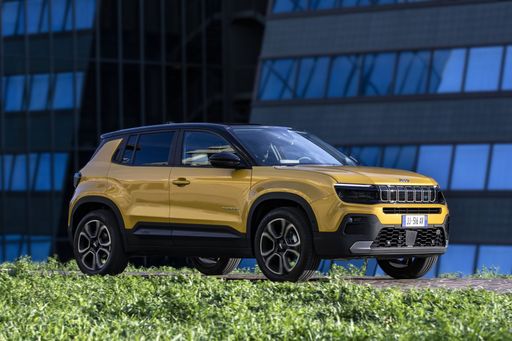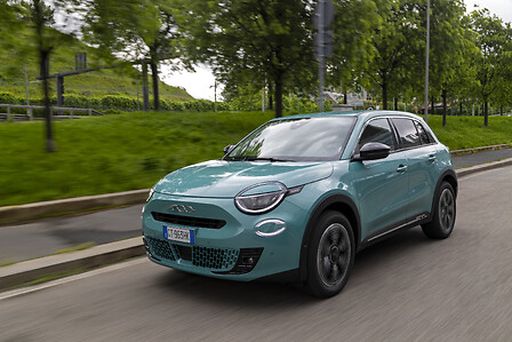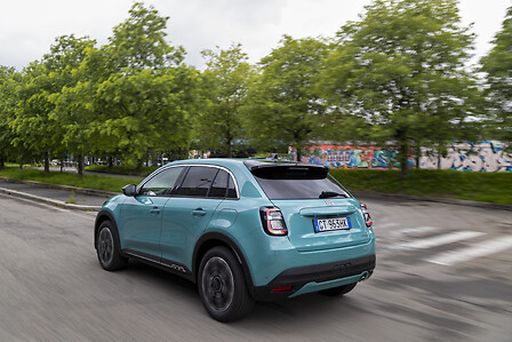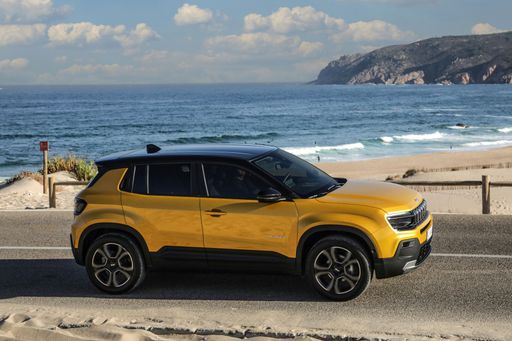The automotive landscape is buzzing with excitement as two formidable players, the Fiat 600 and the Jeep Avenger, enter the SUV market with their unique offerings. Both vehicles appeal to a diverse audience looking for style, performance, and innovation. This article delves into a technical comparison of these two SUVs, examining engine capabilities, efficiency, and overall performance.
Fiat 600 vs Jeep Avenger – Differences & prices compared
Compare performance, boot capacity, efficiency and price at a glance.
Find out which car is the better choice for you – Fiat 600 or Jeep Avenger?
Design and Dimensions
The Fiat 600 stands at a length of 4178 mm and a width of 1779 mm, topped with a height of 1525 mm. In contrast, the Jeep Avenger is slightly more compact, measuring 4084 mm in length and 1776 mm in width, with a taller stature of 1528 mm. Both vehicles feature a five-door design, comfortably seating five passengers, making them ideal for urban environments and family outings.
Powertrains and Performance
The Fiat 600 offers a range of powertrains, including a petrol MHEV and an electric variant, providing power outputs of 100 HP, 136 HP, and up to a robust 156 HP. In comparison, the Jeep Avenger also provides similar engine options, showcasing a max output of 156 HP. The Fiat's petrol engines are coupled with a dual-clutch automatic transmission, while the Avenger offers flexibility with both automatic and manual gearbox options.
Acceleration tells a compelling story for both models. The Fiat 600 races from 0-100 km/h in as quickly as 8.5 seconds, while the Jeep Avenger matches up closely with an impressive 9 seconds for its most potent electric variant. Both vehicles showcase innovative engine technologies that enhance performance and provide a dynamic driving experience.
Efficiency and Environmental Impact
In terms of efficiency, the Fiat 600 achieves a remarkable fuel consumption of just 4.8 L/100 km while its electric variant consumes only 15.1 kWh/100 km. Conversely, the Jeep Avenger’s best petrol variant offers a slightly higher consumption figure of 5.7 L/100 km and an electric consumption of 15.4 kWh/100 km. Both vehicles are designed with environmental consciousness in mind, with the Fiat 600 boasting a CO2 efficiency class of C and the Avenger achieving an impressive class A for its electric model.
Range and Battery Capacity
Electric range can often be a deal-breaker for modern consumers. The Fiat 600 promises an electric range of 409 km, while the Jeep Avenger isn’t far behind, offering a range of 400 km. Both models feature a reliable 51 kWh battery capacity, ensuring they are equipped for both daily commutes and longer journeys.
Interior Space and Cargo Capacity
When it comes to practicality, trunk capacity plays a crucial role. The Fiat 600 provides ample space with a trunk capacity of 385 liters, while the Jeep Avenger lags slightly, offering 355 liters. However, the Jeep compensates for this with a strong payload capability of up to 502 kg compared to the Fiat's 405 kg, enhancing its utility for outdoor adventures.
Driving Experience and Technology
Both vehicles are equipped with sophisticated driving technologies, ensuring a user-friendly experience for all drivers. Advanced infotainment and safety features are becoming standard across both platforms, enhancing the overall driving experience. The Fiat 600 stands out with its seamless automatic transmission, while the Avenger offers drivers the option of manual engagement for those who crave a more hands-on approach.
Conclusion: Which SUV Reigns Supreme?
Choosing between the Fiat 600 and the Jeep Avenger ultimately comes down to personal preference and prioritization of attributes. The Fiat 600 excels in efficiency, trunk space, and acceleration. Meanwhile, the Jeep Avenger offers solid performance and payload versatility, making it a compelling option for adventurous drivers.
Whichever you choose, both the Fiat 600 and the Jeep Avenger represent innovative strides in the SUV market, catering to an audience eager for style, performance, and practicality.
Here’s where it gets real: The technical differences in detail
Costs and Efficiency:
Price and efficiency are key factors when choosing a car – and this is often where the real differences emerge.
Fiat 600 has a minimal advantage in terms of price – it starts at 21800 £, while the Jeep Avenger costs 21900 £. That’s a price difference of around 94 £.
Fuel consumption also shows a difference: Fiat 600 manages with 4.80 L and is therefore barely noticeable more efficient than the Jeep Avenger with 4.90 L. The difference is about 0.10 L per 100 km.
In terms of energy consumption, the advantage goes to the Fiat 600: with 15.10 kWh per 100 km, it’s minimal more efficient than the Jeep Avenger with 15.50 kWh. That’s a difference of about 0.40 kWh.
As for range, the Fiat 600 performs barely noticeable better – achieving up to 409 km, about 9 km more than the Jeep Avenger.
Engine and Performance:
Power, torque and acceleration say a lot about how a car feels on the road. This is where you see which model delivers more driving dynamics.
Both models deliver identical power – 156 HP each.
In acceleration from 0 to 100 km/h, the Fiat 600 is slight quicker – completing the sprint in 8.50 s, while the Jeep Avenger takes 9 s. That’s about 0.50 s faster.
In terms of top speed, the Fiat 600 performs slight better – reaching 200 km/h, while the Jeep Avenger tops out at 194 km/h. The difference is around 6 km/h.
Both models offer the same torque – 260 Nm.
Space and Everyday Use:
Cabin size, boot volume and payload all play a role in everyday practicality. Here, comfort and flexibility make the difference.
Both vehicles offer seating for 5 people.
In curb weight, Jeep Avenger is a bit lighter – 1180 kg compared to 1355 kg. The difference is around 175 kg.
In terms of boot space, the Fiat 600 offers barely noticeable more room – 385 L compared to 380 L. That’s a difference of about 5 L.
In maximum load capacity, the Jeep Avenger performs hardly perceptible better – up to 1277 L, which is about 21 L more than the Fiat 600.
When it comes to payload, Jeep Avenger to a small extent takes the win – 502 kg compared to 430 kg. That’s a difference of about 72 kg.
Who wins the race?
The Jeep Avenger proves to be has a very small edge and therefore becomes our DriveDuel Champion!
Jeep Avenger is the better all-rounder in this comparison.
 @ Jeep / Stellantis Media
@ Jeep / Stellantis Media
Jeep Avenger
Fiat 600
The Fiat 600 is a compact city car that embodies the essence of Italian design and practicality. Renowned for its nimble handling and efficient use of space, it offers an enjoyable driving experience for urban commuters. With its classic charm and modern updates, the Fiat 600 remains a beloved choice for those seeking style and functionality in a small package.
details @ Fiat / Stellantis Media
@ Fiat / Stellantis Media
 @ Fiat / Stellantis Media
@ Fiat / Stellantis Media
Jeep Avenger
The Jeep Avenger is a compact SUV that brings a blend of rugged design and modern technology, making it ideal for both urban and off-road adventures. Its robust build and distinctive styling capture Jeep's iconic spirit while offering a comfortable and refined driving experience. With advanced safety features and a versatile interior, the Avenger caters to a wide range of drivers looking for practicality and excitement.
details @ Jeep / Stellantis Media
@ Jeep / Stellantis Media
 @ Jeep / Stellantis Media
@ Jeep / Stellantis Media
 @ Jeep / Stellantis Media
@ Jeep / Stellantis Media
 @ Jeep / Stellantis Media
@ Jeep / Stellantis Media
 @ Jeep / Stellantis Media
@ Jeep / Stellantis Media
 @ Fiat / Stellantis Media
@ Fiat / Stellantis Media
|
 @ Jeep / Stellantis Media
@ Jeep / Stellantis Media
|
|
|
|
Costs and Consumption |
|
|---|---|
|
Price
21800 - 31300 £
|
Price
21900 - 36900 £
|
|
Consumption L/100km
4.80 L
|
Consumption L/100km
4.9 - 5.7 L
|
|
Consumption kWh/100km
15.10 kWh
|
Consumption kWh/100km
15.50 kWh
|
|
Electric Range
409 km
|
Electric Range
400 km
|
|
Battery Capacity
51 - 52 kWh
|
Battery Capacity
51 kWh
|
|
co2
0 - 109 g/km
|
co2
0 - 129 g/km
|
|
Fuel tank capacity
44 L
|
Fuel tank capacity
44 L
|
Dimensions and Body |
|
|---|---|
|
Body Type
SUV
|
Body Type
SUV
|
|
Seats
5
|
Seats
5
|
|
Doors
5
|
Doors
5
|
|
Curb weight
1355 - 1595 kg
|
Curb weight
1180 - 1520 kg
|
|
Trunk capacity
360 - 385 L
|
Trunk capacity
325 - 380 L
|
|
Length
4178 mm
|
Length
4084 - 4088 mm
|
|
Width
1779 mm
|
Width
1776 mm
|
|
Height
1523 - 1525 mm
|
Height
1527 - 1541 mm
|
|
Max trunk capacity
1231 - 1256 L
|
Max trunk capacity
1218 - 1277 L
|
|
Payload
427 - 430 kg
|
Payload
494 - 502 kg
|
Engine and Performance |
|
|---|---|
|
Engine Type
Electric, Petrol MHEV
|
Engine Type
Electric, Petrol, Petrol MHEV
|
|
Transmission
Automatic
|
Transmission
Automatic, Manuel
|
|
Transmission Detail
Reduction Gearbox, Dual-Clutch Automatic
|
Transmission Detail
Reduction Gearbox, Manual Gearbox, Dual-Clutch Automatic
|
|
Drive Type
Front-Wheel Drive
|
Drive Type
Front-Wheel Drive, All-Wheel Drive
|
|
Power HP
110 - 156 HP
|
Power HP
100 - 156 HP
|
|
Acceleration 0-100km/h
8.5 - 10.5 s
|
Acceleration 0-100km/h
9 - 10.6 s
|
|
Max Speed
150 - 200 km/h
|
Max Speed
150 - 194 km/h
|
|
Torque
205 - 260 Nm
|
Torque
205 - 260 Nm
|
|
Number of Cylinders
3
|
Number of Cylinders
3
|
|
Power kW
81 - 115 kW
|
Power kW
74 - 115 kW
|
|
Engine capacity
1199 cm3
|
Engine capacity
1199 cm3
|
General |
|
|---|---|
|
Model Year
2023 - 2025
|
Model Year
2023 - 2025
|
|
CO2 Efficiency Class
A, C
|
CO2 Efficiency Class
A, D, C
|
|
Brand
Fiat
|
Brand
Jeep
|
What drive types are available for the Fiat 600?
The Fiat 600 is available as Front-Wheel Drive.
The prices and data displayed are estimates based on German list prices and may vary by country. This information is not legally binding.
